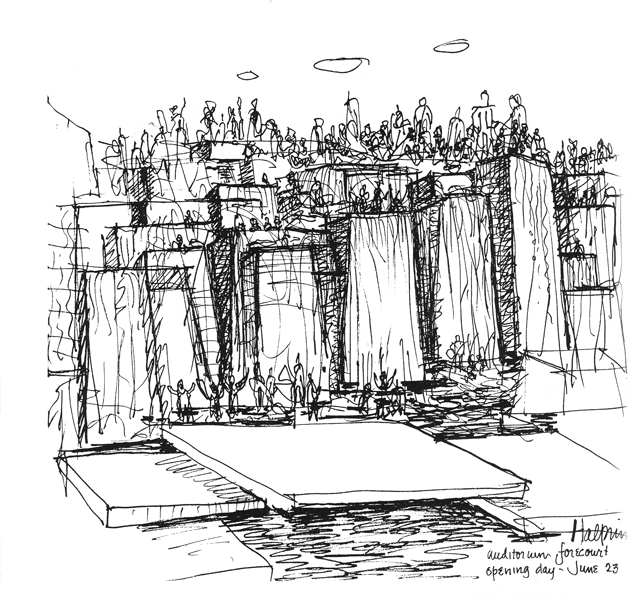Watershed Politics

Lawrence Halprin’s drawing of opening day at forecourt (now Keller) fountain in June 1970
The distance between Keller Fountain and the farms and vineyards of the Willamette Valley can be measured in miles, or the inches between the late landscape architect Lawrence Halprin’s ears.
As Oregon celebrates the 40th anniversary this month of the legislation that protected much of the valley’s agricultural lands, it’s worth a pause to ponder the ways in which one designer’s creative vision helped shape both a city and a region.
Between 1963 and 1970, Halprin and his San Francisco firm completed a series of fountain plazas in Portland’s South Auditorium District loosely based on the idea of a watershed, starting with an artesian spring and ending in a waterfall. Called Lovejoy Fountain, Pettygrove Park, and Forecourt (later renamed Keller) Fountain, they instantly became people magnets, earning photo spreads and critical plaudits across the globe. The final plaza, Keller, with its 13,000-gallon-a-minute cascade, New York Times architecture critic Ada Louise Huxtable called “one of the most important urban spaces since the Renaissance.”
Two years after Keller Fountain opened, Gov. Tom McCall hired Halprin to help sell a vision for another watershed: the Willamette Valley. Halprin’s study, The Willamette Valley: Choices for the Future, would play a pivotal role in McCall’s efforts to pass Senate Bill 100, the law that laid the groundwork for urban growth boundaries. Without the bill or the study, the valley today would almost certainly have fewer farms and vineyards, and more sprawl. But for Halprin, a watershed was a watershed: design metaphor or breadbasket, both deserved to be nice places for people, and for that, you needed to maximize interaction.
Until Halprin’s plazas, Portland public spaces were passive, tree-lined parks. The new fountains offered a hybrid of the town square and the swimming hole. As Halprin wrote in his notebooks, they were designed to “say come in not stay off.” Within months of the opening of the first one—Lovejoy—Portland’s citizens decided they wanted more, holding protests and votes that eventually led to transforming a riverside highway into Tom McCall Waterfront Park and a parking lot into Pioneer Courthouse Square.
The study of the Willamette Valley also invited citizens to “come in”—to the political process. It offered two scenarios for a million more people living in the valley: one developed on the 5- and 10-acre lots much of the valley was zoned for; the other with tight urban growth boundaries. In dozens of town hall meetings Halprin’s team led across the valley, they asked the citizens to get involved and imagine what kind of future they wanted.
With their high, poured-concrete precipices and plunging waters, no city would build these fountains today: liability lawyers and ADA regulations wouldn’t let them. Similarly rowdy political risks would scarcely allow a 21st-century governor to commission a designer like Halprin or a study like Choices for the Future. Even at the time, skeptics in McCall’s administration likened Halprin’s simple, hand-drawn scenarios to the cartoonish world of the Beatles’ still-fresh movie Yellow Submarine: strip malls propagated by “Blue Meanies” in contrast to the “euphoric utopia” of controlled growth.
Yet, four decades later, the Willamette Valley looks a lot more like euphoria than the land of the Blue Meanies. And the first of the statewide planning goals adopted under Senate Bill 100? Citizen involvement. Or as Halprin might have said, “Come on in.”
For our in-depth exploration of urban growth and the Willamette Valley, see our feature article Pushing Boundaries.




